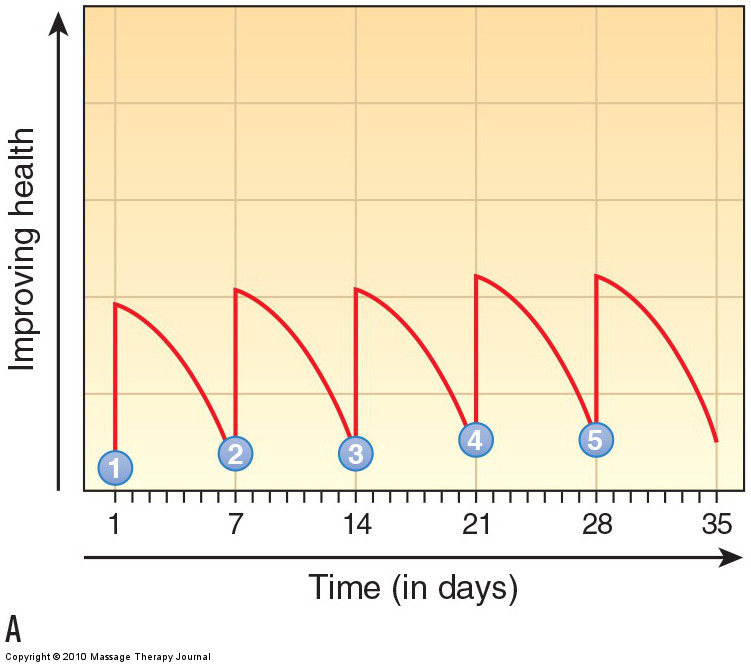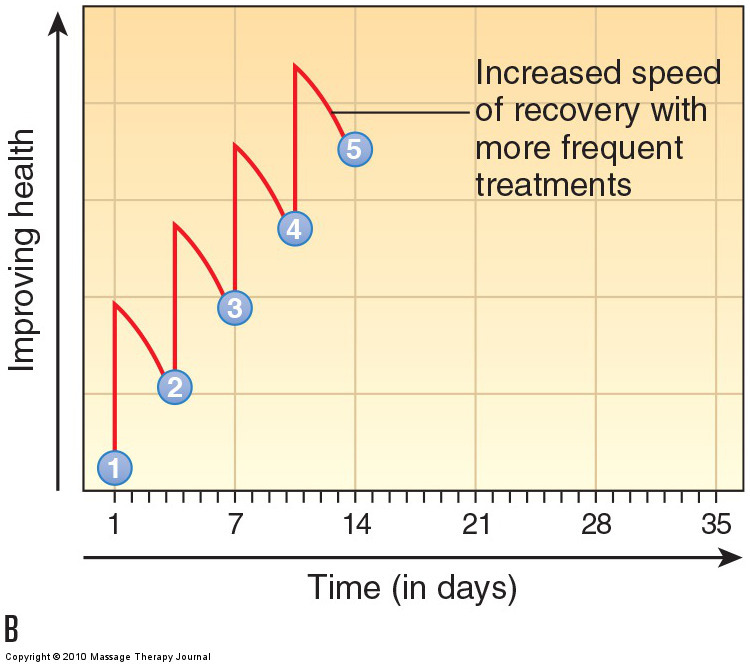This blog post article is part of a series of articles on assessment of the low back and pelvis. Scroll to the end of this article to see the others in this series.
Treatment Strategy


Figure 13. Effects of frequency of care. (A) Treatment frequency of once per week. (B) Treatment frequency of twice per week. Note the increased speed of recovery of the client’s condition when treatments are more frequent. Numbered treatments are indicated in blue circles. Permission Joseph E. Muscolino. Manual Therapy for the Low Back and Pelvis – A Clinical Orthopedic Approach (2015)
Once the health history and physical assessment examination have been performed, a treatment strategy can be developed. This involves creating a treatment plan for the client. Three principle components of a treatment plan must be determined:
- Treatment techniques that will be used during the sessions
- Frequency of sessions
- Self-care advice that will be given to the client
Treatment Techniques
The pathomechanics of the condition will determine the objectives of care, which in turn will determine the treatment techniques to be used. Most conditions of the low back and pelvis involve tight/taut soft tissues (hypertonic musculature and fascial adhesions), so loosening these tissues is usually the primary focus of treatment. Most conditions that have been present for some time also involve joint dysfunction hypomobilities, so joint mobilization should be another focus. It is essential to address both of these aspects of the condition if the client’s musculoskeletal health is to improve.
The treatment techniques presented in these blog posts are designed to address tight muscles and other taut soft tissues as well as joint dysfunction hypomobilities. These techniques tend to be most effective if performed after the client’s tissues have been warmed up. Choosing which technique to use is often a matter of both the therapist’s and the client’s personal preferences. The most effective approach is usually to combine multiple techniques within the treatment plan. (Before employing any new technique in your practice, be sure that it is within the scope of practice of your profession.)
Frequency of Sessions
Regarding treatment strategy, once the techniques have been chosen, the next step is to decide the optimal frequency of care. Again, this depends on the circumstance. If a client is basically healthy and simply wants to maintain good health, the frequency might vary from once a week to once a month, depending on the client’s lifestyle and health. However, if a client has a musculoskeletal condition that needs to be remedied, physical rehabilitation requires a frequency of two to three times per week. This is common in physical therapy, chiropractic, strength training, and sport training, and the same holds true for all fields of manual therapy.
Each treatment session must build on the previous one if the client is to improve. Performing a treatment physically changes both the state of the tissues and the neural patterns for muscle contraction. As time passes after the session, these changes are gradually lost as the body reverts back to the pattern of its pathologic condition. If too much time elapses between visits, then the client continually regresses back to his or her dysfunctional pattern before the successive treatment occurs. Therefore, for care to be effective and efficient, treatments should be spaced no more than 2 to 3 days apart until the desired improvement has been achieved (Fig. 13). Although this may seem like a strong commitment to ask of a client, it is the most time-efficient and cost-efficient approach.
(Click here for a blog post article on precautions for manual therapy of the lumbar spine and pelvis.)
This blog post article is the 16th in a series of 18 blog posts on the subject of assessment of the low back and pelvis.
The blog post articles in this series are:
- Introduction to Assessment of the Low Back and Pelvis
- Health History
- Introduction to Physical Assessment Examination of the Low Back and Pelvis
- Postural Assessment of the Low Back and Pelvis
- Range of Motion and Manual Resistance Assessment of the Low Back and Pelvis
- Muscle and Bone Palpation of the Low Back and Pelvis
- Joint Motion Palpation Assessment
- Overview of Special Orthopedic Assessment Tests of the Low Back and Pelvis
- Straight Leg Raise Tests for Space-Occupying Lesions
- Cough Test and Valsalva Maneuver
- Slump Test
- Piriformis Stretch Test
- Straight Leg Raise and Manual Resistance Tests for Strains and Sprains
- Nachlas and Yeoman’s Tests
- Sacroiliac Joint Medley of Tests
- Treatment Strategy for the Low Back and Pelvis
- Self-Care Advice for the Client with a Low Back / Sacro-Iliac Joint Condition
- Brief Review of Assessment and Treatment of Conditions of the Low Back and Pelvis


